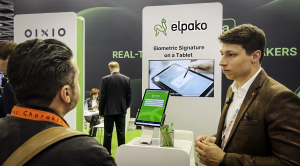Virtual Printer – Elpako New Feature for Fast Document Signing
Signing documents directly from the print window isn’t new—but Elpako took a fresh approach and made it faster and even more intuitive. With the Virtual Printer, the process is as straightforward as:
Open → “Print” → Sign.
No pop-ups, no redundant steps—just a smooth, self-explanatory workflow. Fewer clicks. More efficiency.
Key Benefits
Simplicity
- Send your document directly to Elpako signing platform straight from the print window—no need to download, open your browser, or manually upload anything.
- The entire process takes less than 15 seconds.
Versatility
- Compatible with any application: Word, Excel, PDF, PowerPoint, JPG, PNG, browsers (Chrome, Edge, Firefox), documents from Google Drive, and emails from Outlook or Gmail.
- Automatically converts any file type into a PDF for signing.

Freedom of Choice
- Choose between a biometric or a qualified e-signature. You can sign the document yourself or invite someone else to sign.
- You see the document instantly and place your signature exactly where it needs to go—with a simple click or drag of your mouse.
Centralized Management
- All signed documents are securely stored on Elpako platform, with convenient tools for search, viewing, analysis, and exporting.
- You can track who has signed and easily resend the document for signing if needed.
Security
- All signatures meet eIDAS and ISO security standards, ensuring full legal validity.
- Because the document remains digital and never leaves the secure environment, risks like data leaks or printing errors are minimized.
When to Use the Virtual Printer vs. the Platform
The Virtual Printer is ideal when the document is already prepared and doesn’t require any additional information to be filled in—such as when an HR department sends a confidentiality agreement to a new employee for signature.
The platform is best suited for cases where the document needs to be both filled out and signed—for example, when a patient at a medical facility must provide details about their health condition and sign a consent form before a procedure.
How It Works – Step by Step
-
Install the Elpako Virtual Printer tool on your computer.
-
Open the print window in any program and select “Elpako Virtual Printer” from the printer list.
-
Log in to your Elpako biometric signing account (only needed the first time).
-
Choose your signature type: biometric or qualified e-signature.
-
Sign the document—it will be instantly saved on the Elpako platform.

Biometric vs. Qualified E-Signature – What’s the Difference?
Both signature types are legally valid, but they’re suited for different contexts—in-person or remote.
-
Biometric Signature
Best for in-person signing, such as at a customer service desk.
Signed using a tablet and digital pen, capturing unique traits like pressure, speed, and movement. -
Qualified E-Signature
Ideal for remote signing.
Uses Smart-ID, Mobile ID, or a national ID card. Legally equivalent to a handwritten signature.
Try It Today
The Virtual Printer is now available to all Elpako Biometric Signature users.
Try it out and experience a faster, simpler way to sign documents—right from your desktop.
Med.I.S. and Elpako Integration – More Capabilities in a Single Solution
Digitization has long moved beyond basic administrative tasks. Today’s biggest challenge is ensuring that every step – from patient registration to signing medical documents – happens quickly, securely, and without the need for paper.
This is where the integration of Med.I.S. and Elpako comes in. Imagine a workflow where signing documents is not a separate task but a natural part of your daily routine – done right on a tablet during patient interaction. It’s not just convenient – it’s a major step toward fully digital healthcare.
Med.I.S. – Driving Efficiency in Your Facility
Med.I.S. is a unified information system that connects every part of your healthcare facility. It’s more than just software – it’s a solution built on years of real-world medical experience, trusted by around 40 healthcare providers across Lithuania.
Designed to adapt to any organization – whether you have five or five hundred employees – Med.I.S. helps streamline and elevate your operations.

Key Benefits:
Operational Efficiency:
- Standardizes and automates internal workflows, reducing human error and saving valuable staff time.
- Supports better resource management and lets you focus on what matters most – patient care.
- Reduces administrative costs and boosts overall institutional performance.
Seamless Coordination and Usability:
- Aligns all departments for smooth collaboration and efficient information flow.
- Operates in real time – giving you access to the most current data.
- Modular structure easily adapted to your specific institutional needs.
- Ergonomic and intuitive – easy to learn and use in everyday work.
Legal Compliance:
- Constantly updated to reflect the latest legal requirements.
- Integrated with the National Health Insurance Fund system “SVEIDRA” and its subsystems (SPAP, PRAP, APAP) – automating data exchange and reducing manual tasks.
Elpako – A Signature That Simplifies, Not Complicates
Signing documents shouldn’t stand in the way of digital progress. With Elpako’s biometric signature integrated into Med.I.S., you can sign documents directly on a tablet – quickly, smoothly, and legally. Forget printing, scanning, and archiving.

Top Benefits:
Flexibility:
- Choose between biometric and qualified electronic signatures depending on the context.
- Suitable for both staff and patient signatures – providing convenience across all areas of operation.
Speed and Convenience:
- Signing takes only seconds – no delays or extra steps.
- Templates make it easy to create recurring documents, reducing administrative burden.
- Assisted mode lets the staff and patient view the same document on separate screens – the patient on a tablet, the physician on a computer.
Security and Legal Validity:
- Captures unique biometric data – stylus pressure, movement, and signing speed – ensuring authenticity and protection against forgery.
- Complies with the eIDAS regulation – the EU-wide legal standard for electronic signatures.
- Signature data is encrypted and securely stored at the time of signing – preserving integrity and preventing tampering.
Digital Maturity – When the Signature Becomes Part of the Process
Digitization in healthcare shouldn’t stop at document signing. With Elpako integrated into Med.I.S., signing becomes part of the real work – done on the tablet, alongside the patient.
It’s not an extra step – it’s a seamless, modern, and trusted solution that works naturally for everyone involved.
Want to See It in Action?
Contact us today!
www.elpako.lt | [email protected] | +370 620 54 160
Don’t let paper and slow processes hold your facility back.
Choose a digital solution that works.
GITEX Europe 2025. The Future Inspires, but Real Solutions Address Today’s Challenges
After the exhibition, Justina shared insights into Europe’s digitalization landscape. In May 2025, Germany launched its first Ministry for Digitalization and State Modernization, aiming to centralize and strengthen digital processes. However, as the Elpako team notes, bringing this vision to life still faces major obstacles.
Due to Germany’s federal structure, digital progress varies widely across institutions. Some public agencies are implementing advanced solutions, while many still rely on outdated methods for document management. An estimated 80–90% of documents are still sent by fax. Meanwhile, the country’s waste management sector is among the most advanced, using smart cameras and AI to analyze recycling quality.
“This contrast clearly shows that digitalization is uneven. While some sectors use advanced technologies, fundamental processes—like document handling—are still being neglected,” explains Justina.
In this context, Elpako believes the true value lies not in showcasing the latest technologies, but by applying them where they truly solve user problems. The electronic signature stands out as a key element in digital transformation, enabling smooth, secure, and legally sound processes across both public and private sectors.
“Our goal is to deliver solutions that impact everyday life—not with futuristic ideas, but with concrete results. Signing should be fast, intuitive, and reliable,” emphasizes Elpako Product Director.

Technology Inspires – but It’s Valuable Where It Works Today
At GITEX Europe, high-tech innovations took center stage. These included breakthroughs in quantum computing and the latest in financial technologies. One standout was the IBM Quantum System Two, a next-gen quantum system marking a leap forward in AI and supercomputing.
Elsewhere at the exhibition, lively discussions revolved around digital wallets and identity verification. The fintech sector introduced not only technical solutions but also fresh perspectives on making digital payments more trustworthy, faster, and user-friendly. Many participants stressed the growing interest in seamless identity recognition, using biometric data or digital ID wallets. This shift reflects not just technological progress, but also a new approach to building trust.
Amid the innovation, serious warnings also emerged. Artificial intelligence was a key topic, not just in displays but in discussions. Cybersecurity behavior analyst Mark T. Hofmann gave a compelling talk on the ‘dark side of AI’, revealing how criminals exploit generative models like ChatGPT, WormGPT, and deepfakes through techniques like prompt engineering and jailbreaking. His message was clear: the more powerful the technology, the greater the responsibility in how it’s used.
“Innovation should stay grounded in reality. Tech developers must consider not just what’s possible, but how it impacts people’s everyday experiences,” notes Justina.

Elpako’s Vision: Solving Where It Hurts Most
The Elpako biometric signature platform isn’t just for show; it’s built for real-world use. It allows users to quickly and securely sign documents on a tablet, use templates, work in assisted mode, and integrate seamlessly via API into existing systems. Fully compliant with the eIDAS regulation, the platform is suitable for both public and private sectors.
“When the process works, it saves time, prevents errors, and strengthens trust between clients and organizations. That’s what true digitalization should deliver,” Justina emphasizes.

Purposeful Partnerships for Thoughtful Growth
During the event, Elpako met with Ferrari Electronic AG. This company builds secure and efficient communication systems. With experience across public and private sectors, Ferrari Electronic helps develop digital solutions that meet high legal standards and user expectations.
“Collaborating with partners like this allows us not only to build a product but also to contribute to broader digital transformation efforts. It’s not just about growth—it’s about responsibility,” Justina shares.
The future may inspire us, but the solutions that truly transform experiences are rooted in a deep understanding of how things work today. Elpako embraces that vision, developing technology that serves people, not the other way around.
When Business Moves Faster Than Its Paperwork
These scenarios are common—not because people don’t want to work efficiently, but because the tools they have can’t keep up. A mechanic inspects a vehicle with the client, yet still has to fill out paperwork at the front desk. Logistics specialists carry folders around the warehouse because they don’t have time to get back to a computer. Real estate agents return to the office just to send out documents via email. All these disruptions slow down workflows, increase the chance of errors, and ultimately hold businesses back.
What Does True Business Mobility Look Like?
Today, business must go where the customer is—mobile, agile, and fast. But true mobility requires more than a laptop or a smart device. It demands a shift in mindset: a continuous flow of information and decisions made in real time, on-site. Traditional document management—offices, paperwork, printers, disconnected systems—creates friction where there should be flow.
Digital mobility isn’t just about convenience. It represents a change in business culture: less formality, more trust between employee and customer; less waiting, more engagement. It fosters not only productivity but a better emotional work environment—where processes help rather than hinder. That’s exactly what Elpako Biometric Signature Platform enables: seamless, secure, and legally valid work—without interruption.

What Does Real Mobility Look Like?
Elpako solution is more than just an electronic signature. It’s a complete approach to document management—done through a single device, in one system, without extra steps:
-
Pre-built templates – no need to create documents on the spot.
-
On-site form completion and biometric signing – right where the job happens.
-
Instant document delivery – to clients or colleagues, with automatic syncing to your company’s document management system.

Four Real-World Scenarios from Everyday Business
Auto Repair Shop
A mechanic discusses necessary repairs with the client on-site. The details are immediately recorded in a digital form, photos of the vehicle are attached, and everything is signed using a tablet with a biometric signature. The form is then emailed to the client. No extra paperwork, no administrative burden. The client gets full transparency and documented proof—saving time and avoiding any confusion.
Field Service Teams
A technician responds to a burst pipe at a client’s home. He records the work done, adds photos, signs the document on a tablet, and the form is instantly sent to both the client and the office. No printing, no phone calls. The client gets immediate confirmation, and the company gets an accurate record.
Equipment Rental
A technician delivers construction equipment to a job site. The handover form is completed on a tablet, equipment condition is recorded, photos attached, and both parties sign biometrically. The document goes straight to the office. All the information is stored where it’s needed and ready when it’s needed—essential when equipment moves between multiple sites daily.
Insurance Claims
An insurance assessor visits a client’s home after an incident. They document the damage, complete necessary forms, add photos, sign the report on a tablet, and send it straight into the insurer’s system. The client doesn’t need to visit an office, and the claims process begins within minutes—easing stress and accelerating service.

Why This Matters for You
Maybe your company’s processes are technically “under control”—but how much time does it really take? Filling out paper documents on-site, transferring and sending them, making phone calls to confirm details—these steps cost work hours. Employees often revisit clients just to “finalize” a process, leaving customers uncertain about the outcome.
Smooth document management isn’t a bonus—it’s a foundation. When the system runs without friction, clients feel confident and employees feel in control. This isn’t just about saving time. It’s about peace of mind, speed, and respect for everyone’s time.
Businesses that adopt mobile signing solutions often see a 15–30% increase in services completed during a single visit. That means not only happier customers, but real financial results—fewer return visits, less wasted time, and more revenue per working hour.
If your team still waits to “handle documents” at a computer, it means one thing—you’re losing efficiency every single day.
Mobility Principles That Transform Customer Service
-
Speed: Less waiting, more doing.
-
Accuracy: Data is captured immediately—reducing the risk of forgetting or mixing things up later.
-
Trust: Clients are involved in the process and understand every step.
-
Efficiency: One visit = task completed.

Mobility isn’t the future—it’s the present, and the fast are already winning.
While some are still figuring out schedules and paperwork logistics, others are completing entire workflows on the spot, in just minutes. Some wait—others act. Every delayed step is a lost opportunity to deliver at the right time.
Digitization isn’t just a tech upgrade. It’s a way to free up time, reduce stress, and let your team focus on what they do best—serving clients, not managing paperwork. When documentation becomes invisible, business becomes faster, clearer, and more pleasant for everyone involved.
The less someone feels like they’re “handling documents,” the more efficient your organization becomes. Not because documents aren’t important—but because they no longer get in the way. When information flows seamlessly, your business moves decisively and quickly.
Start working faster, simpler, and smarter—with the Elpako Biometric Signature Platform.
To learn more, contact Business Development Manager Rokas Jašinskas at +370 620 54 160 or email [email protected].